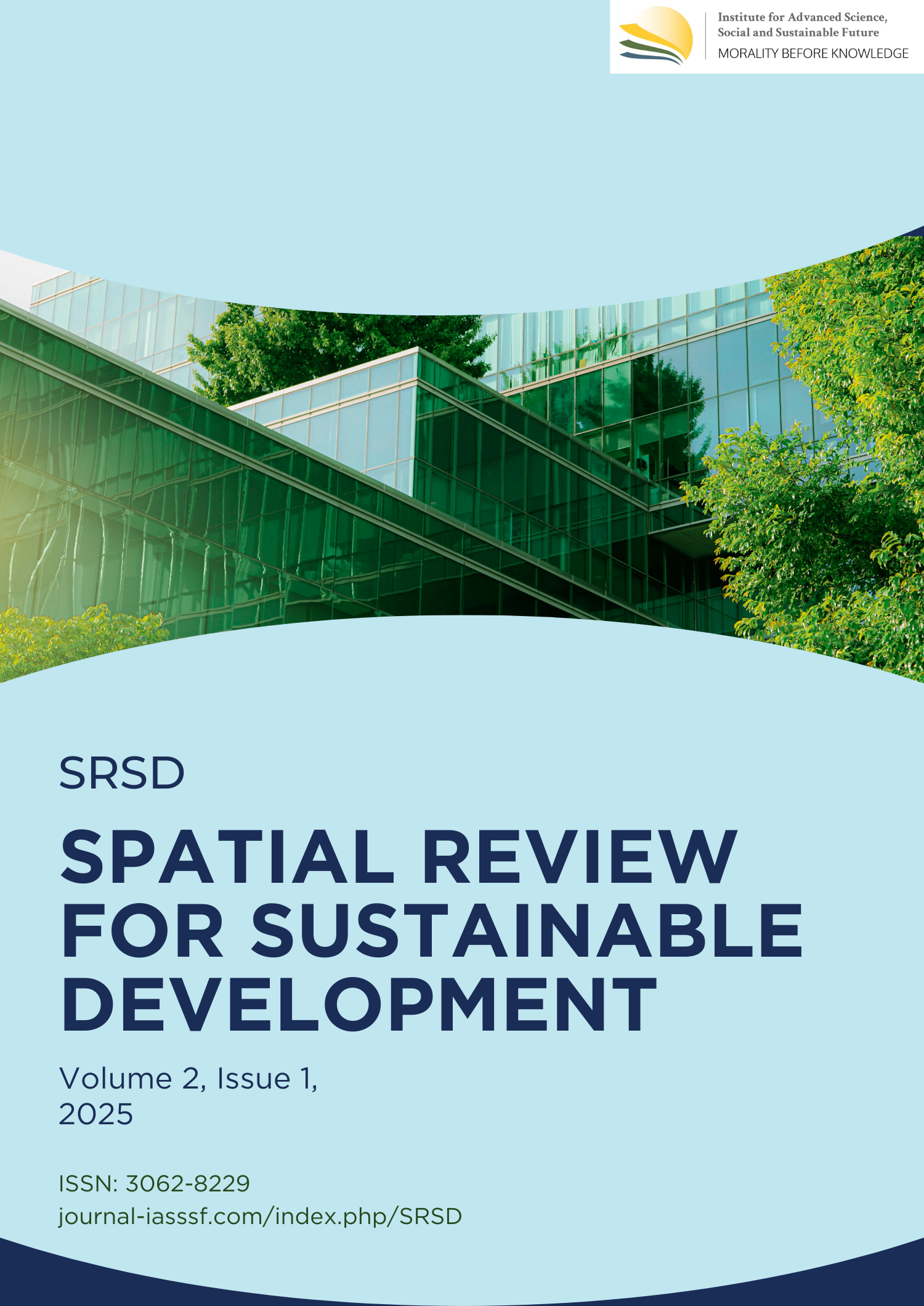Spatial prioritization of urban green open space development using weighted overlay analysis
DOI:
https://doi.org/10.61511/srsd.v2i1.2025.1707Keywords:
green open space, weighted overlay analysis, NDVI, THIAbstract
Background: Urban areas are ecosystems where plants, animals, humans, and infrastructure interact. Green open spaces (RTH) like parks are vital in cities for facilitating this interaction. However, rapid urbanization and limited land often lead to the conversion of green spaces into built-up areas, which increases urban temperatures, disrupts ecosystems, and lowers the quality of life for city dwellers. The allocation of RTH development is often not aligned with the community's actual needs. This study aims to determine the priority locations for RTH development in Mataram City using the Weighted Overlay method in the ArcGIS application. Method: This study employs a qualitative approach using spatial analysis through the Weighted Overlay method in ArcGIS. Three key variables are considered: the comfort index (THI), vegetation density (NDVI), and population density. The data from these variables are combined to assess and prioritize areas in Mataram City for RTH development. Findings: The analysis shows that the sub-districts of Mataram and Cakranegara have the highest priority for RTH development, based on the combined analysis of comfort index, vegetation density, and population density. These areas require more green space to improve environmental quality and meet the community’s needs. Conclusion: The study highlights the importance of prioritizing RTH development in Mataram and Cakranegara sub-districts. It suggests that urban planning policies in Mataram City should focus on these areas to enhance urban living conditions and mitigate environmental degradation caused by limited green spaces. Novelty/Originality of this article: This research is unique in applying the Weighted Overlay method in ArcGIS to evaluate and prioritize RTH locations based on multiple urban variables. It provides valuable insights for urban planners, offering a data-driven approach to address the challenges of green space distribution in urban environments.
References
Worldmeter (2024). Current world population. https://www.worldometers.info/world-population/. 14 Oktober 2024. Pkl. 21.34 WIB.
Widyaningrum (2018). PBB: 68% Populasi Dunia Akan Tinggal di Area Perkotaan Pada 2050. https://nationalgeographic.grid.id/read/13673071/pbb-68-populasi-duni8a-akan-tinggal-di-area-perkotaan-pada-2050?page=all. 14 Oktober 2024. Pkl. 21.00 WIB.
Heryanto, B. (2011). Roh dan Citra Kota: Peran Perancangan Kota sebagai Kebijakan Publik. Brilian Internasional
Kurniawati, F. E. (2010). Perkembangan Struktur Ruang Kota Semarang Periode 1960- 2007. Skripsi. Fakultas Geografi. UMS : Surakarta, 2007, 1–29.
Brundtland, G. H. (1987). Report of the World Commission on environment and development:" our common future.". London, England: United Nations.
Mayona, E.L. (2021). KONSEP ECOLOGICAL CITY DALAM KERANGKA KONSEP EKOLOGI KOTA DAN KOTA BERKELANJUTAN (Vol. 18, Issue 2). https://doi.org/DOI:10.30659/jpsa.v18i2.17978.
Cohen, B. (2006). Urbanization in developing countries: Current trends, future projections, and key challenges for sustainability. Technology in Society, 28(1–2), 63–80. https://doi.org/10.1016/j.techsoc.2005.10.005.
Nurfadhil, R., & Zain, A. F. M. (2024). Evaluasi Ketersediaan Ruang Terbuka Hijau dan Penerapan Konsep Kota Hijau di Provinsi DKI Jakarta. Journal of Regional and Rural Development Planning, 8(1), 76–95. https://doi.org/10.29244/jp2wd.2024.8.1.76-95.
Saha, B., & Atiqul Haq, S. M. (2024). Perception of urban green space among university students in Bangladesh. PLoS ONE, 19(9). https://doi.org/10.1371/journal.pone.0311033
Sobol A, Skubała P. (2022) Students’ perceptions and their derived satisfaction of urban forests in the most industrialised region of poland. Economics and Environment. 2022; 77(2): 126–143. https://doi.org/10.34659/2
Kim SK, Joosse P, Bennett MM, van Gevelt T. (2020) Impacts of green infrastructure on flood risk perceptions in Hong Kong. Climatic Change. 2020; 162:2277–99. https://doi.org/10.1007/s10584-020-02803-5.
Umar, R., Abidin, M. R., Nur, R., Atjo, A. A., Liani, A. M., Yanti, J., & Utama, I. M. (2022). Penentuan Prioritas Ruang Terbuka Hijau Menggunakan Metode Weighted Overlay. Jurnal Geosains Dan Remote Sensing, 3(2), 88–94. https://doi.org/10.23960/jgrs.2022.v3i2.97
Humaida, N. (2016). Metode penentuan prioritas Ruang Terbuka Hijau di Kota Banjarbaru kalimantan selatan. Bogor .
Lasaiba, M. A., & Tetelepta, E. G. (2023). Analisis spasial kerapatan vegetasi kota ambon berbasis normalized difference vegetation index (NDVI). Jurnal Pengembangan Kota, 11(2), 124–139. https://doi.org/10.14710/jpk.11.2.124-139.
Utomo, W. A., Suprayogi, A. dan Sasmito, B. 2017. Analisis Hubungan Variasi Land Surface Temperature Dengan Kelas Tutupan Lahan Menggunakan Data Citra Satelit Landsat (Studi Kasus: Kabupaten Pati).
Guntara, I 2016. Analisis Urban Heat Island Untuk Pengendalian Pemanasan Global Di Kota Yogyakarta Menggunakan Citra Penginderaan Jauh.
Wachid, N., & Prananing Tyas, W. (2022). Analisis Transformasi NDVI dan kaitannya dengan LST Menggunakan Platform Berbasis Cloud: Google Earth Engine (Vol. 19, Issue 1).
Indonesia. Undang-undang (UU) Nomor 26 Tahun 2007 tentang Penataan Ruang. Lembaran Negara RI Tahun 2007 Nomor 68, Tambahan Lembaran RI Nomor 4725, Sekretariat Negara. Jakarta.
Permen Agraria dan Tata Ruang No 14 Tahun 2022 tentang penyediaan dan pemanfaatan Ruang Terbuka Hijau. Diakses tanggal 10 Oktober 2024 dari https://peraturan.bpk.go.id/Details/255207/permen-agrariakepala-bpn-no-14-tahun-2022.
Kota Mataram. 2019. Peraturan Daerah (Perda) Kota Mataram Nomor 5 Tahun 2019 tentang perubahan atas peraturan daerah nomor 12 tahun 2011 tentang rencana tata ruang wilayah kota mataram tahun 2011 – 2031. Pemerintah Kota Mataram. Mataram.
Published
Issue
Section
Citation Check
License
Copyright (c) 2025 Dani Maulitayanti

This work is licensed under a Creative Commons Attribution 4.0 International License.











